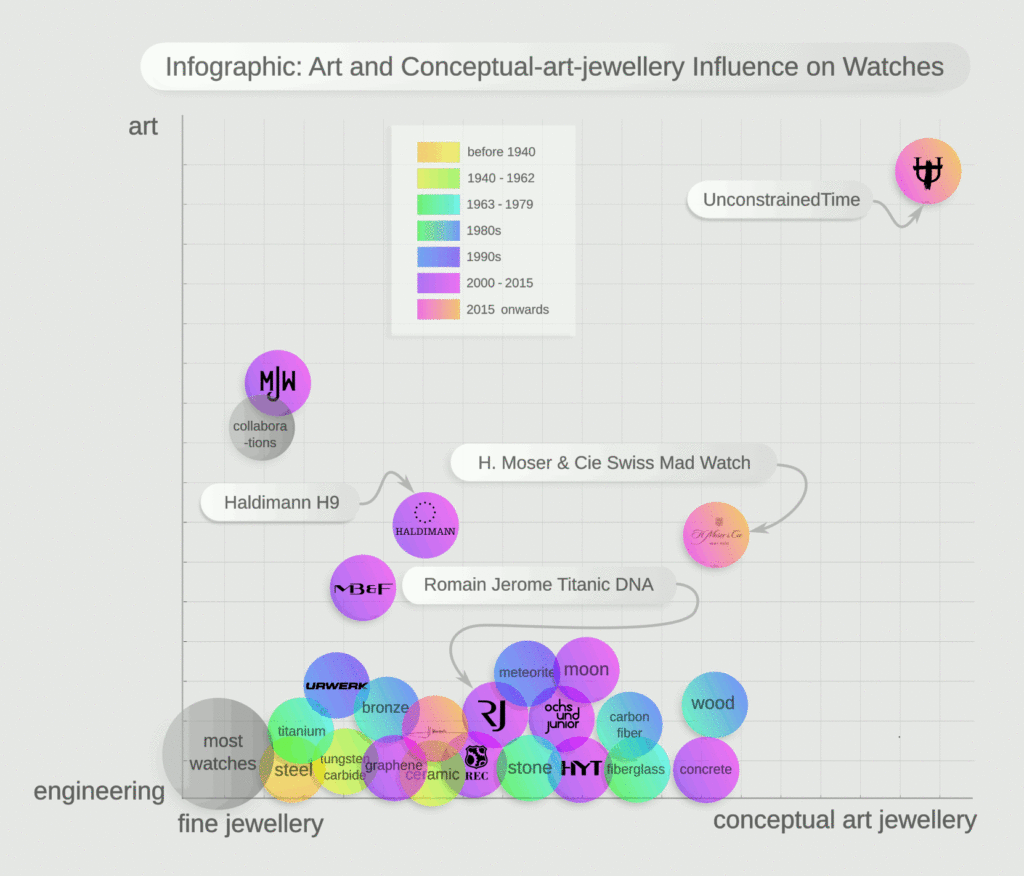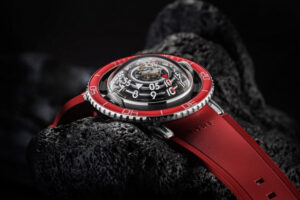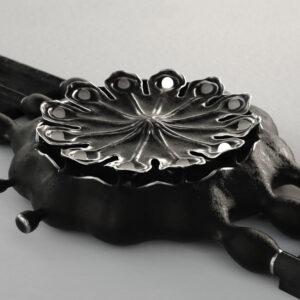By Chris Melchior.

Definitions:
The infographic above can be seen as having a gradient from design to art, on both of the axes. Details about that, below . . .
Engineering: “The branch of science and technology concerned with the design, building, and use of engines, machines, and structures.” (from Oxford Languages)
The definition I am using for art is a cluster of factors, all of which must be present for an object to be art:
- Art is enjoyed for its own sake, not for it’s practical usefulness,
- Art is focused more on aesthetics than on functionality,
- Art is more than intrinsic than decorative,
- Art has special focus,
- Art is unique,
- Art is creativity relating to conceptual ideas used as a means to communicate, evoke emotions and present challenge perspectives and concepts,
- Art is personal.
Details about each of those factors are in my article “Are Watches Art?“.
Comparison of fine jewellery with art jewellery:
| Fine Jewellery: | Art Jewellery: |
| materials: precious metals, precious gemstones | can include any material |
| simple symbolized forms | can include complex forms (organic, broken, fractal etc.) |
| highly polished surfaces | surfaces can be complex, rough, organic, broken, fractal etc. |
| design | some sub-categories (including conceptual-art-jewellery) are art |
| symbolized, polished, decorated & decorative | can use materials, forms and surfaces as what they are |
| valued by materials and brand | valued as art |
Comparison of use of organic influences from fine jewellery and art jewellery perspectives:
See how these two watches use their organic influences very differently:
The beautiful and unusual watch with the red strap, (MB&F Horological Machine 7 (The Aquapod)) is based on the shape of a jellyfish, but see how that shape is fully symbolized using the very simple geometric forms and polished surfaces which are part of the fine jewellery design language, and conceptually different from the subtle and complex organic form and textures of a real jellyfish.
Contrast that with the black watch (UnconstrainedTime Poppy Seed Pod) which is based on the fascinatingly complex forms of the poppy seed pod, deliberately retaining their original organic nature, without symbolizing at all, and is available in blackened-silver material with a rough, grainy surface texture (as shown above). These two factors of both form and surface being complex, define the result (and the conceptual approach which led to it) as being within the conceptual art jewellery field. Fine jewellery is design, and conceptual-art-jewellery fits the definitions of being art (detailed above).
Art jewellery evolved in the early 20th C, and influenced some watches to a gradually increasing, although still relatively minor, extent until recent times. Then UnconstrainedTime took the leap of being watches fundamentally based on conceptual-art-jewellery, letting go of almost all of the fine jewellery and engineering influences of conventional watchmaking while retaining its profound links to the horological tradition in its use of an intuitively easy-to-understand 12-point time-display concept based originating from ancient Near East time-keeping.
There are various subcategories of art jewellery, from artisan craftsmanship (which is design), to conceptual-art-jewellery (which is fine art and meets the factors of the definition of art detailed above).
Examples of art jewellery: see our Pinterest Board on art jewellery.
You might be interested in my unique perspective on the inevitability of art jewellery watches, which includes examples of timepieces influenced by art jewellery, and how art jewellery is part of the biggest revolution in the western art tradition, that no-one seems to have noticed.
I have used the gradient from fine jewellery to conceptual-art-jewellery on the horizontal axis of the infographic (above), since, like the gradient from engineering to art, it is a gradient from design to art.
Notes on the items shown in our infographic:
Most watches other than those shown in colour on this infographic (above), are obviously based on a combination of engineering and fine jewellery to varying degrees. The engineering part of this is engineering for tracking and displaying the time, which includes both mechanical engineering, electronic engineering in digital watches, and a combination of both in quartz watches with mechanical watch hands. The fine jewellery influence includes precious metals, simple shapes and polished surfaces.
Most collaborations between artists and watchmakers have some art on the dial of an otherwise conventional watch, with the art having little or no relationship with the rest of the watch. These could be considered art plus a watch, a watch plus some art, or an example of decorative art (which is defined as design rather than art).
Materials used in watches:
The introduction of each of the materials below in watchmaking is a step away from fine jewellery, in which the “fine” refers to the use of precious metals (gold, silver, platinum etc.) and precious gemstones only and always with highly polished surfaces.
The use of each of these materials below, beginning in the year detailed, is partly a gradual progression away from fine jewellery towards increasing use of art jewellery’s acceptance of any material and surface, as well as being partly due to the technical challenges of using each of these materials effectively in watchmaking.
- Steel From 1930. Although materials such as steel had been used in the movements of watches and clocks since the beginning, they were rarely featured on the visible parts of watches until the 1930’s.
- Ceramic. From 1962.
- Tungsten Carbide. From 1962.
- Stone. From 1963.
- Fiberglass. From 1969.
- Titanium. From 1970.
- Carbon fibre. From 1980.
- Wood. From 1988.
- Bronze. From 1988. Although popular these days, bronze watches are a relatively recent innovation.
- Meteorite dials. From 1990.
- Moon material. From 2009.
- Concrete. From 2016.
- Graphene. From 2017.
Specific watches:
Romain Jerome Titanic DNA collection. 2007. A watch with a bezel made of stabilized rusted steel from the Titanic. Use of this material makes the bezel of this watch part of the art-jewellery space.
Haldimann H9. 2008. A watch which doesn’t tell the time. The fact that it is more about a concept than the conventional functionality of a timepiece makes it more towards art and conceptual-art-jewellery and further from engineering.
H. Moser & Cie Swiss Mad Watch. 2017. A watch with a case made from real cheese combined with resin to create a polymer. The case of this watch is part of the art-jewellery space and also not based on engineering functionality.
Watchmakers (and year of launch):
Urwerk. 1997. While still very much based in engineering, their watches seem to me to be more about aesthetics than functionality, and explore further from watchmaking conventions than most. They would certainly draw special attention in today’s society. Those are some of the factors of the definition of art (as detailed above).
MB&F. 2005. The design of some of their watches originate from the creator’s childhood obsessions, they have a significant focus on aesthetics, and would draw special attention in today’s society. Those are some of the factors of the definition of art, while the watches also derive the majority of their influences from traditional watchmaking engineering and functionality.
Ochs and Junior. 2006. Their proudly unpolished watch parts are often described as “Bauhaus”, and also make them significantly part of the art jewellery space, moving away from fine jewellery’s insistence on highly polished surfaces.
Mr Jones watches. 2007. Art or illustration on the dial and hands, inside an otherwise conventional watch. I’ve placed these slightly further towards art than other collaborations because the watch hands are often part of the art rather than part of the conventional watch design, unlike with most collaborations between artists and watchmakers.
HYT watches. 2012. Their use of liquid as a time indicator is a departure from the fine jewellery space.
REC Watches. 2014. Incorporating parts of recycled vehicles, also a departure from the fine jewellery space.
Holthinrichs. 2016. Proudly displaying raw 3D printed texture in some areas of their watches, placing them partly in the art jewellery space.
UnconstrainedTime. 2025. The first watch brand where the whole of the watch is conceptual-art-jewellery and fully fits all defining factors of art, while also being rooted in the world of horology with our simple time-display embodying the 12-hours per day concept from the ancient Near East.
What is your definition of how art differs from design? Comment below, or let us know in our social-media (see the links near the bottom of each page).
Author: Chris Melchior

This article was authored by Chris Melchior, founder of UnconstrainedTime and creator of the original range of wrist-worn sculptures of this unique artistic adventure.
Chris has extensive knowledge and experience of creativity, including fine art and cutting-edge contemporary music composition, and was awarded a First Class Honours Degree in fine art and music with a minor in philosophy.
Chris’s life-long artistic obsessions include organic forms and textures, abstraction, fractals, and the aesthetic essence of musical genres.
He has developed unusually deep insights into the elemental concepts underlying areas including Eastern and Western philosophies, science and technology, creativity and the arts, as well as empirical spirituality in which he is acknowledged as a leading authority.
He has a profound fascination and love for the unique and synergistically creative combination of fine art with the ancient essence of time-keeping which evolved into the UnconstrainedTime project.



Leave a Reply